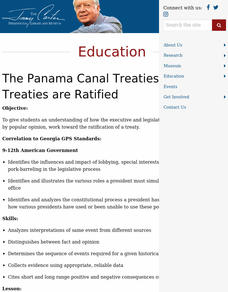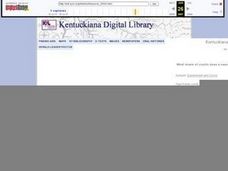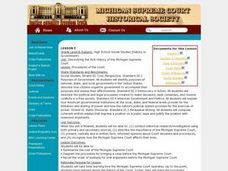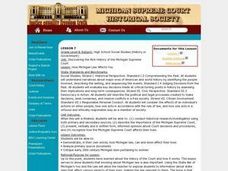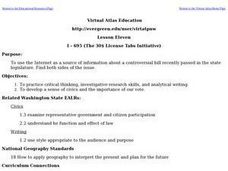Curated OER
Potus and PowerPoint
Fifth graders research a president of the United States and create a PowerPoint presentation. They demonstrate their knowledge of the executive branch of our government and use the Internet to conduct their research for their PowerPoint...
Curated OER
The Panama Canal Treaties: How Treaties Are Ratified
Students gain an understanding of how the executive and legislative branches, influenced by popular opinion, work toward the ratification of a treaty. They examine the influences and impact of lobbying and special interests in the...
Curated OER
Heroes, Elders, Historic Figures, Contemporary Tribal Leaders
Fifth graders research famous Elders. They receive a list of Elders, Historic Figures and Contemporary Tribal Leaders (included with the activity). They discuss the Essential Question to guide their research. Students take notes based on...
Curated OER
Statehouse Time Capsule
Fourth graders create a time capsule that is representative of their community. They explain why the chosen objects are representative of themselves or their community.
Curated OER
The President's Roles and Responsibilities: Communicating with the President
Students examine the roles and responsibilities of the U.S. president and their own roles as citizens of a democracy. They explore various websites, listen to a State of the Union address, and write a letter to the President of the...
Curated OER
The Embodied Presidency
Tenth graders compare and contrast the immigration reform policies of Presidents Reagan and Bush. In this immigration lesson, 10th graders examine primary documents related to each president's policy for immigration reform. Students...
National Endowment for the Humanities
Ratifying the Constitution
Ratifying the Constitution was no simple task. Using primary sources, such as classic writings from the Federalists and Anti-Federalists, young scholars examine the arguments for and against the Constitution. They then decide: Would they...
Curated OER
Michigan Judicial System Conclusion
Learners identify the courts that make up Michigan's judicial system. They state the responsibilities of each court and diagram a flow chart of how a case moves to the Michigan Supreme Court. They participate in a quiz about the current...
Curated OER
Michigan Court System (Part 1) (Middle School)
Students identify the courts that make up the Michigan judicial system. They explore the responsibility of each court and diagram how cases move to the Supreme Court. They compare and contrast the different types of courts.
Curated OER
The life of a legislative bill
Students investigate bills under consideration by the United States Congress and create a flow chart that tracks the movement of the bills to gain understanding of the legislative process.
Curated OER
You and the U.S. Constitution
Fourth graders explore the U.S. Constitution and how is protects the rights and freedoms of American citizens. They run through various circumstances and decide whether a person's rights have been violated.
Curated OER
Federal Court Systems and Court Cases
Ninth graders investigate the basis for the Common Law Tradition. They examine the organization of the Federal Court System and students identify the various sources of the American Law.
Curated OER
The Preamble to the Constitution: How Do You Make a More Perfect Union?
Students analyze the Preamble of the Constitution and identify the historical context that led to its wording. They, in groups, interpret phrases from the Preamble, examine relevant court cases and create illustrations for their portion...
Curated OER
Procedures of the Court
Students examine the role of the Michigan Supreme Court. They diagram the procedure one must follow to bring a case before the Court. They discuss the order of business for oral arguments as well.
Curated OER
Michigan United Conservationists Club (M.U.C.C). v. Michigan Secretary of State: An Issue of Referendum
High schoolers observe the procedures of the Michigan Supreme Court. They identify the processes and procedures being used. They debate a case that was presented to the Court and analyze the oral arguments of the case.
Curated OER
History of the Michigan Supreme Court from the Territorial Court and the founding of the Michigan Supreme Court in 1836 to Justice Mary S. Coleman and her interpretation of "One Court of Justice"
Students trace the history of the Michigan Supreme Court from when the state was still a territory. They define procedures as they relate to the Court. They compare and contrast the territorial court to the new Court.
Curated OER
Brown v. Board of Education of Topeka
Twelfth graders explore desegregation as it occurred at various stages in United States history. They specifically chronicle the role of South Carolina in the desegregation case of Brown v. Board of Education.
Curated OER
How Michigan Law Affects You
Students examine how the laws in Michigan affect their lives. They use primary source documents to analyze the state's history. They discuss laws pertaining to women as well.
Curated OER
I 695 (The 30$ License Tabs Initiative)
Students research the bill I 695 issue. They discuss the topic before they research the issue of I 695. Students discuss how new laws are always being created and the differences in opinion about these laws. They see how this initiative...
Curated OER
Eighth Grade Social Studies Quiz
For this Georgia social studies assessment worksheet, 8th graders respond to fifteen multiple choice questions based on eighth grade social studies skills.
Curated OER
Benjamin Franklin and the U.S. Constitution
Students explore U.S. history by completing a quiz about civics. In this Benjamin Franklin lesson, students read assigned text about Franklin's role in the development of the Constitution and the creation of a new society. Students...
Constitution Facts
U.S. Constitution Crossword Puzzles: Basic #2
Fifty prompts make up a crossword puzzle that challenges scholars to show what they know about the U.S. Constitution.
Curated OER
You and the U.S. Constitution
Fourth graders write new rules of their school. For this rules and U.S. Constitution lesson, 4th graders discuss why we celebrate the fourth of July and examine the U.S. Constitution. Students discuss the differences between people now...
Curated OER
History Review: Colonial America
Explore key moments in American history with the click of a mouse! Learners read 50 questions from different eras in early America, and watch the rest of the presentation to find more questions to answer.

